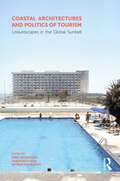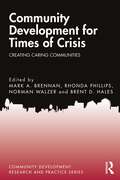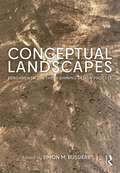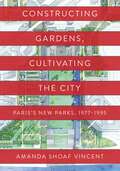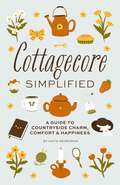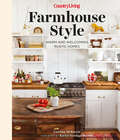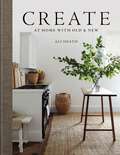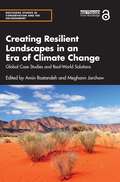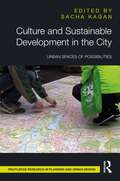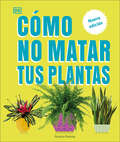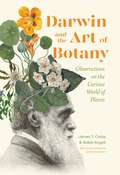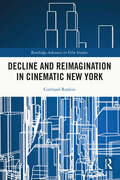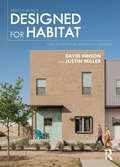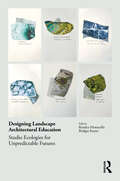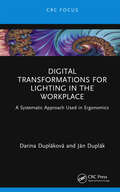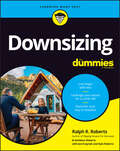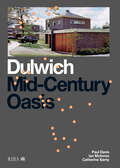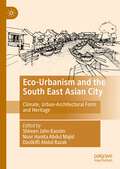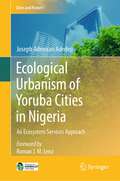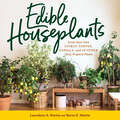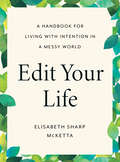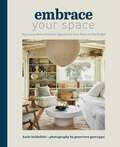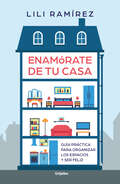- Table View
- List View
Coastal Architectures and Politics of Tourism: Leisurescapes in the Global Sunbelt
by Sibel BozdoǧanThis volume offers a critical and complicated picture of how leisure tourism connected the world after the World War II, transforming coastal lands, traditional societies, and national economies in new ways.The 21 chapters in this book analyze selected case studies of architectures and landscapes around the world, contextualizing them within economic geographies of national development, the geopolitics of the Cold War, the legacies of colonialism, and the international dynamics of decolonization. Postwar leisure tourism evokes a rich array of architectural spaces and altered coastal landscapes, which is explored in this collection through discussions of tourism developments in the Mediterranean littoral, such as Greece, Turkey, and southern France, as well as compelling analyses of Soviet bloc seaside resorts along the Black Sea and Baltic coasts, and in beachscapes and tourism architectures of western and eastern hemispheres, from Southern California to Sri Lanka, South Korea, and Egypt. This collection makes a compelling argument that "leisurescapes," far from being supra-ideological and apolitical spatial expressions of modernization, development, and progress, have often concealed histories of conflict, violence, social inequalities, and environmental degradation. It will be of interest to architectural and urban historians, architects and planners, as well as urban geographers, economic and environmental historians.
Community Development for Times of Crisis: Creating Caring Communities (Community Development Research and Practice Series)
by Mark A. BrennanThis book explores the intersection of community development and local capacity building as a basis for effective disaster mitigation and the alleviation of suffering in times of crisis. Beginning with the Community Development section, the process, context, and methods for community, engagement, and development can be viewed from different structural and logical approaches. This section explores some of the more relevant historical arguments, as well as more contemporary examinations. The second section looks at Critical Human and Community Considerations and sheds light on some of the key concepts that are often overlooked (poverty, race, inequality, social justice, mental health, social division) when framing community responses to disaster. The third section focuses on Fundamental Elements of Caring Communities. This section explores the importance, practical, and measurable impacts of social support, empathy, inclusion, and conflict resolution in creating effective and caring community responses. Finally, the last section focuses on practice and brings together research and theory into applied programming, examples, and evidence from on-the-ground efforts to establish caring communities that respond to local needs in times of crisis and beyond. By addressing these objectives, this book provides a more complete understanding of the essential role that community can play in disaster mitigation. Doing this will provide a better focus for ongoing research endeavors, and program and policy initiatives at the community level that seek to prepare for, respond to, and recover from natural and other disasters. As a result, this book contributes to wider and more sustainable development of our communities beyond disasters, while furthering dialog among community scholars and practitioners.
Conceptual Landscapes: Fundamentals in the Beginning Design Process
by Simon M. BussiereConceptual Landscapes explores the dilemma faced in the early moments of design thinking through a gradient of work in landscape and environmental design media by both emerging and well-established designers and educators of landscape architecture. It questions where and, more importantly, how the process of design starts. The book deconstructs the steps of conceptualizing design in order to reignite pedagogical discussions about timing and design fundamentals, and to reveal how the spark of an idea happens – from a range of unique perspectives. Through a careful arrangement of visual essays that integrate analog, digital, and mixed-media works and processes, the book highlights differences between diverse techniques and triggers debate between design, representation, technology, and creative culture in the field. Taken together, the book’s visual investigation of the conceptual design process serves as a learning tool for aspiring designers and seasoned professionals alike. By situating student work alongside that of experienced teachers and landscape architects, the book also demystifies outdated notions of individual genius and sheds new light on the nearly universally messy process of discovery, bridged across years and diverse creative vocabularies in the conceptual design process. Lavishly illustrated with over 210 full color images, this book is a must-read for students and instructors in landscape architecture.
Constructing Gardens, Cultivating the City: Paris’s New Parks, 1977-1995 (Penn Studies in Landscape Architecture)
by Amanda Shoaf VincentConstructing Gardens, Cultivating the City is the first cultural history of major new parks developed in Paris in the late twentieth century, as part of the city’s program of adaptive reuse of industrial spaces. Thanks to laws that gave the city more political autonomy, Paris’s local government launched a campaign of park creation in the late 1970s that continued to the turn of the millennium. The parks in this book represent this campaign and illustrate different facets of their cultural and historical context.Archival research, interviews, and analyses of the parks reveal how postmodern debates about urban planning, the historic city, public space, and nature’s presence in an urban setting influenced their designs. In sum, the city adopted the garden as a model for public parks, investing in complex, richly symbolic and representational spaces. These parks were intended to represent contemporary twists on traditional designs and serve local residents as much as they would contribute to Paris’s role as a world city.The parks’ development process often included points of conflict, pointing to differing views on what Parisian space should represent and fundamental contradictions between the characteristics of public space and the garden as it is traditionally defined. These parks demonstrate the ongoing cultivation of the city over time, in which transformed sites not only fulfil new functions but also engage with history and their surroundings to create new meaning. They stand for landscape as a form of signifying cultural production that directly engages with other art forms and ways of knowing. Just as the Luxembourg Gardens, the Tuileries, and the Buttes-Chaumont parks exemplify their eras’ cultural dynamics, such parks as the Jardin Atlantique, Parc André-Citroën, and the Jardin des Halles express contemporary French culture within the archetypal space of their era, the city. Finally, they point the way to current trends in landscape architecture, such as citizen gardening and ecological initiatives.
Cottagecore Simplified: A Guide to Countryside Charm, Comfort and Happiness (Simplified Series)
by Katie MerrimanImagine this: you have a hot cup of tea and a good book in front of you, the aroma of freshly baked bread in the air as sunlight streams in through the window. Daydreaming of a simpler life? Go back to the basics with Cottagecore Simplified.It might not be practical to drop everything and live out your fairytale fantasy, but it&’s easy to embrace countryside comfort while coexisting with the modern world—find inspiration in the crafts, décor, and lifestyle tips in this book. This guide is designed to bring peace and relaxation to your life.Inside you&’ll find:Recipes for baked breads, pies, pastries, and moreEmbroidery, sewing, and quilt patternsIdeas for sketches and doodlesAn introduction to candle and soap makingTips for maintaining your gardenPottery, flowerpressing, and other charming craftsAnd more!Life is all about enjoying the simple things. This idyllic aesthetic allows you to break from monotony and routine. Start off friends and family in their new home with this ideal housewarming gift, or take the plunge yourself into DIY projects and low-waste living. Unplug from the modern world and bring cottagecore to your everyday life with Cottagecore Simplified.
Country Living Farmhouse Style: Warm and Welcoming Rustic Homes
by Caroline McKenzieAdd rustic country charm and make home your favorite place to be. This collection of classic and modern farmhouses inspire easy and comfortable living. Farmhouse style is about cultivating connection, embracing the simple life, and bringing a kick-up-your-feet, linger-a-little-longer feeling to your home. Step inside 20 beautifully-designed homes and discover how to create the cozy and practical country vibe. An intimate look inside these homes reveals how designers blend elements of old and new and add a touch of distinctive character to every room. You&’ll tour a renovated New York farmhouse that pairs classic architecture with a fresh color palette for a hip yet historic look and discover how designer Lauren Leiss artfully refreshes a Virginia Colonial-style home with reclaimed floors and exposed beams. Plus, peek inside a ranch-style Texas home built from scratch which displays old-time charm inside and out. (Think: tons of textured cozy lived-in rooms featuring aged furniture and collections of time-worn books and oiled paintings.)Whether you are looking to upgrade your kitchen with an apron-front sink, add shiplap to your walls, or introduce flair to your living space with flea market finds, this expansive collection of farmhouses will inspire homeowners who plan to renovate or decorate a new home or make the perfect gift for anyone who dreams of a farmhouse of their own.
Create: At Home with Old & New
by Ali HeathSome of the most exciting interiors around are those that layer vintage and antique finds with select contemporary pieces. In Create, interior stylist and journalist Ali Heath encourages you to think imaginatively about how to bring together old and new at home - introducing individuality and interest, while incorporating the need to decorate more sustainably.Following on from the success of her first book Curate, Create is a visual feast divided into three engaging and informative chapters. Establishing Your Style will fire your imagination, while Adding the Magic considers various decorating elements, including pattern and texture, curiosities and collections, furniture and furnishings, art and display, and lighting. In Creative Spaces the homes of a maverick group of 10 antique dealers and interior designers are shared - offering a mix of pared-back neutral homes and more colourful spaces -,providing a fresh new take on artfully combining old and new. The book is full of insightful advice from experts and gives readers a valuable sourcebook to return to for inspiration. With glorious photography, original drawings and break-out ideas pages, Create will give you the confidence to nurture a home you love - one that celebrates the past while embracing the present and future.
Create: At Home with Old & New
by Ali HeathSome of the most exciting interiors around are those that layer vintage and antique finds with select contemporary pieces. In Create, interior stylist and journalist Ali Heath encourages you to think imaginatively about how to bring together old and new at home - introducing individuality and interest, while incorporating the need to decorate more sustainably.Following on from the success of her first book Curate, Create is a visual feast divided into three engaging and informative chapters. Establishing Your Style will fire your imagination, while Adding the Magic considers various decorating elements, including pattern and texture, curiosities and collections, furniture and furnishings, art and display, and lighting. In Creative Spaces the homes of a maverick group of 10 antique dealers and interior designers are shared - offering a mix of pared-back neutral homes and more colourful spaces -,providing a fresh new take on artfully combining old and new. The book is full of insightful advice from experts and gives readers a valuable sourcebook to return to for inspiration. With glorious photography, original drawings and break-out ideas pages, Create will give you the confidence to nurture a home you love - one that celebrates the past while embracing the present and future.
Creating Resilient Landscapes in an Era of Climate Change: Global Case Studies and Real-World Solutions (Routledge Studies in Conservation and the Environment)
by Amin Rastandeh Meghann JarchowThis book delivers a realistic and feasible framework for creating resilient landscapes in an era of anthropogenic climate change. From across six continents, this book presents fifteen case studies of differing sociocultural, economic, and biophysical backgrounds that showcase opportunities and limitations for creating resilient landscapes throughout the world. The potential to create socio-ecological resilience is examined across a wide range of landscapes, including agricultural, island, forest, coastal, and urban landscapes, across sixteen countries: Argentina, Australia, Brazil, Denmark, Finland, Greece, Guatemala, Japan, Mexico, Norway, Samoa, South Africa, the United States, Turkey, Uruguay, and Vanuatu. Chapters discuss current and future issues around creating a sustainable food system, conserving biodiversity, and climate change adaptation and resilience, with green infrastructure, nature-based architecture, green-tech, and ecosystem services as just a few of the approaches discussed. The book emphasizes solution-oriented approaches for an "ecological hope" that can support landscape resiliency in this chaotic era, and the chapters consider the importance of envisioning an unpredictable future with numerous uncertainties. In this context, the key focus is on how we all can tackle the intertwined impacts of climate change, biodiversity loss, and large-scale land-cover conversion in urban and non-urban landscapes, with particular attention to the concept of landscape resiliency. The volume provides that much-needed link between theory and practice to deliver forward-thinking, practical solutions. This book will be of great interest to students, researchers, practitioners and policymakers who are interested in the complex relationship between landscapes, climate change, biodiversity loss, and land-based conversion at local, national and global scales.
Culture and Sustainable Development in the City: Urban Spaces of Possibilities
by Sacha KaganThis book exposes the potential to advance a cultural approach to sustainable urban development. It explores urban "spaces of possibilities" and links them to the seized or missed opportunities for innovative forms of transversal partnerships throughout the city and of culturally sensitive urban policies. The call for sustainability brings with it challenges for which, in view of the urgency of social transformation, institutional innovations are necessary. Sustainable urban development will only succeed through creative impulses, experiments, trying out innovative ideas, and making alternatives visible, in particular through locally rooted urban initiatives, artistic actions, and social movements. Discussing many concrete examples from several years of empirical research in the cities of Hanover and Hamburg (Germany), Baltimore and Chicago (USA), Bangalore (India), St. Petersburg (Russia), Singapore, and Vancouver (Canada), the book connects urban spaces and their actors; looks at their guiding principles, strategies, and concrete practices; and identifies new levers, networks, and alliances. Readers will find in this book not only inspiring examples of culture in everyday life in the city but also explanations about the qualities that make local cultural initiatives especially full of potentials, and how they may translate into city-wide changes, engaging with the whole City as Space of Possibilities. The book will interest researchers and advanced students in the interdisciplinary fields of urban studies, sustainability science/sustainability research, cultural sciences, urban sociology, and sociology of the arts/cultural sociology; and those interested in the transdisciplinary collaborations between the arts, academia, and civil society.
Culture and Sustainable Development in the City: Urban Spaces of Possibilities (Routledge Research in Planning and Urban Design)
by Sacha KaganThis book exposes the potential to advance a cultural approach to sustainable urban development. It explores urban "spaces of possibilities" and links them to the seized or missed opportunities for innovative forms of transversal partnerships throughout the city and of culturally sensitive urban policies.The call for sustainability brings with it challenges for which, in view of the urgency of social transformation, institutional innovations are necessary. Sustainable urban development will only succeed through creative impulses, experiments, trying out innovative ideas, and making alternatives visible, in particular through locally rooted urban initiatives, artistic actions, and social movements. Discussing many concrete examples from several years of empirical research in the cities of Hanover and Hamburg (Germany), Baltimore and Chicago (USA), Bangalore (India), St. Petersburg (Russia), Singapore, and Vancouver (Canada), the book connects urban spaces and their actors; looks at their guiding principles, strategies, and concrete practices; and identifies new levers, networks, and alliances. Readers will find in this book not only inspiring examples of culture in everyday life in the city but also explanations about the qualities that make local cultural initiatives especially full of potentials, and how they may translate into city-wide changes, engaging with the whole City as Space of Possibilities.The book will interest researchers and advanced students in the interdisciplinary fields of urban studies, sustainability science/sustainability research, cultural sciences, urban sociology, and sociology of the arts/cultural sociology; and those interested in the transdisciplinary collaborations between the arts, academia, and civil society.
Cómo no matar tus plantas (How Not to Kill Your Houseplant): Nueva edición
by Veronica PeerlessPor mucho que riegues tus plantas siguen estando débiles: hojas que se caen, amarillean y tienen manchas. ¿Qué ocurre? Esta guía de plantas de interior te explica de manera fácil los problemas que pueden estar sufriendo.Detecta las señales de peligro, aprende cómo puedes rescatarlas y descubre qué planta se adapta mejor a tus necesidades. Puedes colocarlas en espacios muy diferentes: baños, cuartos fríos, encima del escritorio, en el marco de una ventana, en un rincón sombrío o en un solárium caliente. ¡Crea tu propio oasis dónde tú quieras!Este libro de plantas también incluye: Consejos para comprender qué les gusta y qué no.Indicaciones sobre cuánta luz, agua, calor y humedad necesitan.Explicaciones para principiantes de las diferentes etapas de crecimiento de la planta.¡Pasa las páginas y descubre cómo salvar a tus plantas! Identifica qué hay plantado en tu maceta y asegúrate de que crezca sana y fuerte. El regalo perfecto para todo aquel que busca poner una planta en su vida y para amantes de las plantas con poca experiencia que quieren adquirir nuevos conocimientos. -------------------------------Learn all the tips and tricks you need to become a proud plant parent – of more than 100 different plants.Yellowed leaves, drooping leaves, dried leaves, even though you've watered it: what&’s going on? How Not to Kill Your Houseplant will explain – and fix – your houseplant woes. Learn to spot the danger signs and take the proper action to rescue your sick plant. Discover the perfect plant for your unique space and needs. Bathrooms, cold rooms, at a desk, on a windowsill, in a gloomy corner or hot suntrap: there are plants for every location to create your own indoor oasis.This perfect plant book further features: Quick tips to understand what your plant does and doesn't like: How much light, water, food, heat, and humidity. Every stage of plant parenting for beginners, from identifying exactly what's in the pot, to keeping it in check when it grows too well. Proving the idea self-purchase or gift purchase for complete beginners who have no experience with or knowledge of plants, as well as [people who want to increase the amount of greenery in their life with indoor plants.
Darwin and the Art of Botany: Observations on the Curious World of Plants
by James T. Costa Bobbi AngellUncover Darwin&’s most important writings about plants with this important collection featuring expert interpretations and rare illustrations. Charles Darwin is best known for his work on the evolution of animals, but in fact a large part of his contribution to the natural sciences is focused on plants. His observations are crucial to our modern understanding of everything from the amazing pollination process of orchids to the way that vines climb. Darwin and the Art of Botany collects writings from six often overlooked texts devoted entirely to plants, and pairs each excerpt with beautiful botanical art from the library at the Oak Spring Garden Foundation, creating a gorgeously illustrated volume that never existed in Darwin's own lifetime, and hasn't since. Evolutionary botanist and science historian James Costa brings his expertise to each entry, situating Darwin's words in the context of the knowledge and research of the time. The result is a new way of visualizing Darwin's work, and a greater understanding of the ways he's shaped our world.
Decline and Reimagination in Cinematic New York (Routledge Advances in Film Studies)
by Cortland RankinDecline and Reimagination in Cinematic New York examines the cinematic representation of New York from the mid-1960s through the mid-1980s, placing the dominant discourse of urban decline in dialogue with marginal perspectives that reimagine the city along alternative paths as a resilient, adaptive, and endlessly inspiring place. Drawing on mainstream, independent, documentary, and experimental films, the book offers a multifaceted account of the power of film to imagine the city’s decline and reimagine its potential. The book analyzes how filmmakers mobilized derelict space and various articulations of “nature” as settings and signifiers that decenter traditional understandings of the city to represent New York alternately as a desolate wasteland, a hostile wilderness, a refuge and playground for outcasts, a home to resilient and resourceful communities, a studio for artistic experimentation, an arcadia conducive to alternative social arrangements, and a complex ecosystem. This book will be of interest to scholars and students of film studies, media studies, urban cinema, urban studies, and eco-cinema.
Designed for Habitat: New Directions for Habitat for Humanity
by Justin Miller David HinsonDesigned for Habitat: New Directions for Habitat for Humanity presents 12 new projects designed and built via collaborations between architects and Habitat for Humanity®. The ways in which we think about affordable housing are being challenged by designers and not-for-profit housing advocates such as Habitat for Humanity and its affiliates. The projects chronicled in this book consider home affordability through the lens of monthly homeownership expenses, energy efficiency and residential energy use, and issues of designed resilience to natural events ranging from aging and accessibility concerns to natural disasters and climate change. New to this edition, the projects reflect new approaches to building scale, construction technology, energy and affordability, and design and context. Illustrated with over 100 color images, the case studies include detailed plans and photographs to show how these projects came about, the strategies used by each team to approach the design and construction process, and the obstacles they overcame to realize a successful outcome. The lessons and insights presented will be a valuable resource, whether you’re an architect, an architecture student, a Habitat affiliate leader, or an affordable housing advocate.
Designing Landscape Architectural Education: Studio Ecologies for Unpredictable Futures
by Rosalea Monacella and Bridget KeaneNo single project or endeavour is immune to the issues that the climate crisis brings. The climate crisis encompasses a broad register of "symptoms" – increased global temperatures and sea-level rise, droughts and extreme bushfire events, salinification and desertification of fertile land, and the list goes on. It reveals and amplifies complex causal relationships that are inherently present and traverse scales, sectors and communities divulging a range of impacts and inequalities. This publication asks designers and academic practitioners to describe their own work through an ecological lens, and then to articulate design approaches for developing new practices in landscape architecture teaching. Designing Landscape Architectural Education: Studio Ecologies for Unpredictable Futures, the Landscape Architecture Design Studio Companion, serves as a resource for academic practitioners in the preparation and delivery of "design-research studios" and students seeking guidance for design methodologies as a part of their landscape architectural education. It draws on the manifold issues of the climate crisis as a set of drivers to examine the utilisation of a range of innovative design approaches to address the current and future priorities of the discipline. The landscape architecture discipline is evolving rapidly to respond to both a broadening and intensification of changes in the environmental, social and political conditions. These changing conditions require innovation that extend the core competencies of landscape architects. This book addresses two fundamental questions – what are the design competencies required of landscape architects to equip them to deal with the complexities brought forth by contemporary society, and as a result, how could we design the future design studio?
Digital Transformations for Lighting in the Workplace: A Systematic Approach Used in Ergonomics
by Darina Dupláková Ján DuplákDigital Transformations for Lighting in the Workplace: A Systematic Approach Used in Ergonomics offers a practical concept for the implementation of digital transformation in ergonomics in work settings. It specifically focuses on providing information about illumination in production and non-production fields, and the described design solutions are applicable in practice. The concepts can be used in a typical manufacturing workplace or an academic setting. The methods in the book complement the modern trend to digitalise the workplace, making the research and practical outcomes of this book compatible with the concept of Industry 4.0 - Digital Manufacturing. This title offers a systematic approach to the field of digital transformation for ergonomics. It presents an opportunity for the reader to learn to create a digital model for lighting by analysing mathematical models for calculation through formulas and simulation algorithms. To put learning into context, this book provides two case studies from the production and non-production sectors, including an example of a classroom. The reader will then be able to utilise the methods to create their own digitized illumination system. This monograph is an ideal read for academics and researchers working at universities in the field of Ergonomics and professionals in industrial management including those in manufacturing plants, ergonomists, designers from the industry sector, or people who are interested in ergonomics, digitization, and simulation of a working environment.
Downsizing For Dummies
by Ralph R. Roberts Joseph Kraynak Kyle Roberts Kathleen RobertsOrganize, declutter, donate—downsize and simplify your life Downsizing For Dummies provides you with strategies to downsize your life by moving to a smaller home, decluttering, simplifying your budget, and saving more money. You&’ll find tips to help decrease your cost of living, lower your home maintenance costs, protect and leverage your assets, and decide whether downsizing is right for you and your family. After downsizing your life, you&’ll save time on household chores and gain the freedom and flexibility that come with having fewer possessions. What will you do with all the time you save? Downsizing For Dummies will help you understand the benefits of living simply! Discover ways to declutter and simplify every corner of your life Weight the pros and cons of moving to a smaller home Save time and money by cutting down on your chores and home maintenance Experience a reduced stress level when you create space at home and workThis book is for anyone who is ready to live clutter-free and to downsize. It&’s the perfect Dummies guide for homeowners looking to save money, plus real estate brokers who are working with clients who are downsizing, and designers and builders of new homes who want to stay on top of the downsizing trend.
Dulwich: Mid-Century Oasis
by Paul Davis Elisabeth Kendall Ian McInnes Catherine SamyDulwich’s mid-century modern architecture is increasingly recognised for its qualities of light, landscape and lifestyle. In the 1950s, 60s and 70s, around 2,000 new homes were created to the most modern standards without destroying the qualities which had made Dulwich so attractive to previous generations. With both historic and new photography, this book showcases the award-winning work of the Dulwich Estate’s architects, Austin Vernon & Partners, working with house builder Wates. Today, there is much to be learned from the architects and landscape planners who saw their role as fundamental to building Britain’s modern society.
Eco-Urbanism and the South East Asian City: Climate, Urban-Architectural Form and Heritage
by Shireen Jahn Kassim Noor Hanita Abdul Majid Dzulkifli Abdul RazakThis book traces the history of urban design in tropical South East Asia with a view to offering solutions to contemporary architectural and urban problems. The book examines how pre-colonial forms and patterns from South East Asian traditional cities, overlaid by centuries of change, recall present notions of ecological and organic urbanism. These may look disorganised, yet they reflect and suggest certain common patterns that inform eco-urban design paradigms for the development of future cities.Taking a thematic approach, the book examines how such historical findings, debates and discussions can assist designers and policy makers to interpret and then instil identities in urban design across the Asian region. The book weaves a discourse across planning, urban design, architecture and ornamentation dimensions to reconstruct forgotten forms that align with the climate of place and resynchronise with the natural world, unearthing an ecologically benign urbanism that can inform the future.Written in an accessible style, this book will be an invaluable reference for researchers and students within the fields of cultural geography, urban studies and architecture.
Ecological Urbanism of Yoruba Cities in Nigeria: An Ecosystem Services Approach (Cities and Nature)
by Joseph Adeniran AdedejiThis book offers in-depth ethnographic analyses of key informants’ interviews on the ecological urbanism and ecosystem services (ES) of selected green infrastructure (GI) in Yoruba cities of Ile-Ife, Ibadan, Osogbo, Lagos, Abeokuta, Akure, Ondo, among others in Southwest Nigeria. It examines the Indigenous Knowledge System (IKS) demonstrated for wellbeing through home gardens by this largest ethno-linguistic group in Nigeria. This is in addition to the ES of Osun Grove UNESCO World Heritage Site, Osogbo; Biological Garden and Park, Akure; Lekki Conservation Centre, Lagos; Adekunle Fajuyi Park, Ado-Ekiti; Muri Okunola Park, Lagos; and some institutional GI including University of Ibadan Botanical Gardens, Ibadan; Federal University of Agriculture Abeokuta Botanical Garden, Abeokuta; and University of Lagos Lagoon Front Resort, Lagos, Nigeria. The study draws on theoretical praxis of Western biophilic ideologies, spirit ontologies of the Global South, and largely, Millennium Ecosystem Assessment (2005) to examine eco-cultural green spaces, home gardens, and English-types of parks and gardens as archetypes of GI in Yoruba traditional urbanism, colonial and post-colonial city planning. The book provides methods of achieving a form of modernized traditionalism as means of translating the IKS into design strategies for eco-cultural cities. The strategies are framework, model, and ethnographic design algorithms that are syntheses of the lived experiences of the key informants.
Edible Houseplants: Grow Your Own Citrus, Coffee, Vanilla, and 43 Other Tasty Tropical Plants
by Byron E. Martin Laurelynn G. MartinThe world of houseplants just got tastier with this colorful guide to growing edible plants indoors! Houseplant enthusiasts will be delighted to discover the range of tropical plants that can be grown in containers indoors, in any location. Laurelynn and Byron Martin, owners of Logee's Plants for Home & Garden, are nationally renowned for their expertise in growing fruit-bearing and tropical plants indoors. Their colorful guide features photos and complete care guidelines for 46 food-bearing plants, includes lemons, limes, grapefruit, cherries, olives, passion fruit, papaya, and much more. Fresh, fragrant, and flavorful, Edible Houseplants expands the fun and pleasure of growing indoor plants.
Edit Your Life: A Handbook for Living with Intention in a Messy World
by Elisabeth Sharp McKettaAn inspiring guide to focusing on what matters most in life—and hitting delete on what doesn&’t. Life is noisier, messier, and more complicated than ever. In our quest to keep up, we can lose sight of what we care about most, and instead try to do it all—with mixed results. In this beautiful call to examine and edit our lives, writer Elisabeth Sharp McKetta shares eight simple ways to cut through the clutter, drama, and overwhelm of modern life to live with more intention and joy. Inspired by her own experiments with reprioritizing, tiny house living, and finding the right balance of work and family time, Edit Your Life brings together personal narrative and practical takeaway, with inspiring results. Whether you&’re pivoting, downsizing, relocating, or just ready to have more time and energy for the people and activities you love most, this engaging and practical guide will bring you on a journey of exploration and reflection—and point you toward the life you truly want to live.
Embrace Your Space: Organizing Ideas and Stylish Upgrades for Every Room on Any Budget
by Katie HoldefehrWhether giving a studio apartment a makeover to maximize every inch of space for storage, creating a functional and streamlined kitchen, or revamping a bedroom into a relaxing sanctuary, home design expert Katie Holdefehr will be your personal designer throughout each step in Embrace Your Space. As an editor for top magazines and websites such as Real Simple, Martha Stewart Living, Good Housekeeping, and Apartment Therapy, Katie Holdefehr honed her expertise in home design and organization writing hundreds of articles and styling dozens of tasteful, livable rooms that anyone on any budget can achieve. Featuring real homes from across the country and accompanied by gorgeous photographs, Embrace Your Space shares Katie&’s tools of the trade, as well as designer-insider tips and tricks, to give every living space a Wow! effect. Also included are simple and affordable design projects for creating unique and custom-looking décor details. GORGEOUS PHOTOGRAPHY: More than 150 beautiful full-color photographs show designer tips and tricks in action DESIGN PROJECTS: Simple, affordable, and easy-to-accomplish design projects are included in each chapter HOME ORGANIZATIONAL HACKS: Dozens of home organization tips help keep areas clutter-free DECLUTTERING TIPS: Learn easy-and-quick ways to declutter and streamline those common problem areas such as closets, kitchen cabinets, entryways, and more. INSIDER TIPS AND TRICKS: Having worked as a magazine editor in the home decor space, Katie Holdefehr provides inLayoution for home design and organization BEAUTIFUL GIFT: Whether you appreciate home design or are just looking to downsize your clutter, this books makes a gorgeous and helpful gift.
Enamórate de tu casa
by Lili RamírezEste libro te cambiará la idea de que eres desordenado por naturaleza y te ayudará a encontrar el bienestar a través de la organización de tu casa. Está comprobado que ordenar los espacios trae muchos beneficios: ayuda a enfocarse y a ser más productivos, reduce el estrés, mejora el sueño y genera felicidad. Parece una tarea titánica poner todo en su sitio, pero esta organizadora profesional te mostrará que no es difícil y te acompañará en el proceso de ordenar cada espacio: el clóset, la cocina, el baño, el depósito, la biblioteca. Además, te enseñará a planear una mudanza sin problemas, a preparar una maleta de viaje ligera, a tener un espacio adecuado de trabajo, y te dirá cómo guardar la decoración de Navidad para que el próximo año no sea una pesadilla sacar el árbol. Todo estará enfocado en un objetivo: volver a enamorarte de tu casa y disfrutar de ese lugar donde recargas energía.
